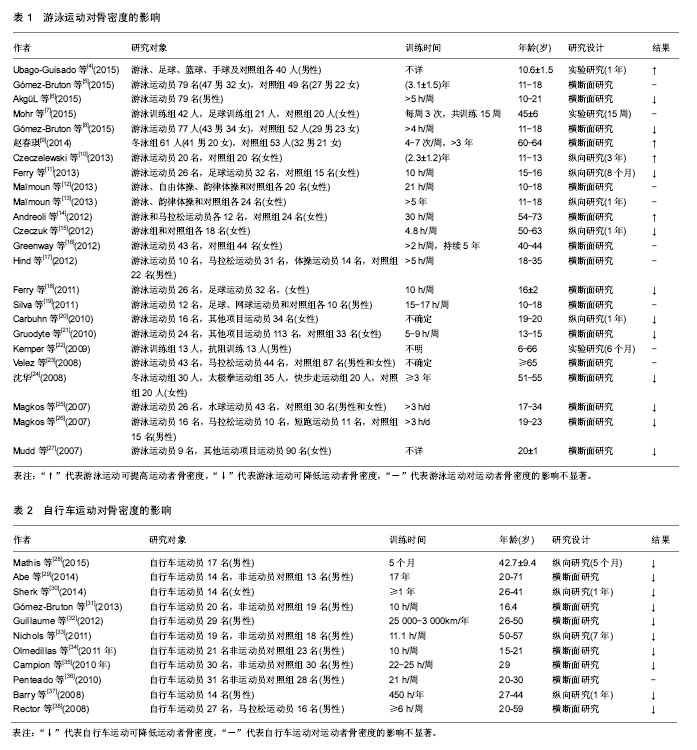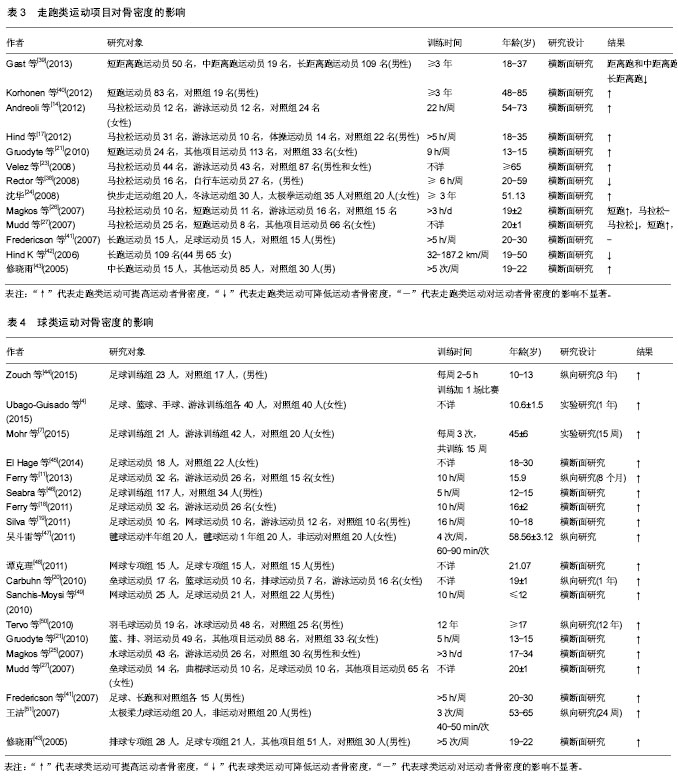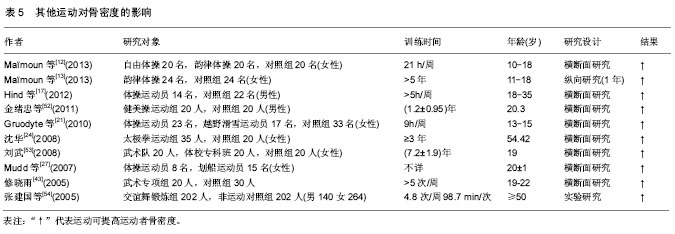| [1] Crandall CJ, Hovey KM, Andrews CA,et al. Bone Mineral Density as a Predictor of Subsequent Wrist Fractures: Findings From the Women's Health Initiative Study. J Clin Endocrinol Metab.2015;100(11): 4315-4324.[2] Vice MA, Nahar VK, Ford MA, et al. Risk Factors for Low Bone Mineral Density in Institutionalized Individuals with Developmental Disabilities. Health Promot Perspect.2015;5(2):147-152.[3] Kim YS, Nam JS, Yeo DW,et al. The effects of aerobic exercise training on serum osteocalcin, adipocytokines and insulin resistance on obese young males.Clin Endocrinol.2015;82(5):686-694[4] Ubago-Guisado E,Gómez-Cabello A,Sánchez-Sánchez J,et al. Influence of different sports on bone mass in growing girls. J Sports Sci.2015; 33(16):1710-1718[5] Gómez-Bruton A, González-Agüero A, Gómez-Cabello A, et al. Bone structure of adolescent swimmers; a peripheral quantitative computed tomography (pQCT) study. J Sci Med Sport. 2015;S1440-2440(15): 232-237.[6] AkgüL S, Kanbur N, Cinemre ?A, et al. The effect of swimming and type of stroke on bone metabolism in competitive adolescent swimmers: a pilot study.Turk J Med Sci.2015;45(4):827-832.[7] Mohr M, Helge EW, Petersen LF, et al.Effects of soccer vs swim training on bone formation in sedentary middle-aged women.Eur J Appl Physiol.2015 ; 115(12):2671-2679.[8] Gómez-Bruton A, González-Agüero A,Gómez-Cabello A,et al.The effects of swimming training on bone tissue in adolescence.Scand J Med Sci Sports.2015, 25(6):589-602.[9] 赵春琪. 冬泳运动对老年人体质和骨密度的影响[J].中国老年学杂志, 2014,34(1):176-177.[10] Czeczelewski J,D?ugo??ecka B,Czeczelewska E,et al.Intakes of selected nutrients, bone mineralisation anddensity of adolescent female swimmers over a three-yearperiod. Biol Sport.2013;30(1):17-20.[11] Ferry B,Lespessailles E,Rochcongar P,et al.Bone health during late adolescence: effects of an 8-monthtraining program on bone geometry in female athletes. JointBone Spine.2013;80(1):57-63.[12] Maïmoun L, Coste O, Philibert P, et al. Peripubertal female athletes in high-impact sports showimproved bone mass acquisition and bone geometry.Metabolism. 2013;62(8):1088-1098.[13] Maïmoun L, Coste O, Mura T, et al. Specific bone mass acquisition inelite female athletes. J Clin Endocrinol Metab.2013;98(7):2844-2853.[14] Andreoli A, Celi M, Volpe SL, et al. Long-termeffect of exercise on bone mineral density and bodycomposition in post-menopausal ex-elite athletes: aretrospective study.Eur J Clin Nutr.2012 ;66(1):69-74.[15] Czeczuk A, Huk-Wieliczuk E, Michalska A, et al. The effect of menopause on bone tissue in formerswimmers and in non-athletes. Adv Clin Exp Med.2012; 21(5):645-652.[16] Greenway KG, Walkley JW, Rich PA. Does long-termswimming participation have a deleterious effect on the adultfemale skeleton? Eur J Appl Physiol.2012;112(9):3217-3225.[17] Hind K, Gannon L, Whatley E, et al. Bonecross-sectional geometry in male runners, gymnasts,swimmers and non-athletic controls: a hip-structuralanalysis study. Eur J Appl Physiol.2012;112(2):535-541.[18] Ferry B, Duclos M, Burt L, et al.Bone geometry and strength adaptations to physicalconstraints inherent in different sports: comparison betweenelite female soccer players and swimmers. J Bone MinerMetab.2011;29(3):342-351.[19] Silva CC, Goldberg TBL, Teixeira AS, et al. The impact ofdifferent types of physical activity on total and regional bonemineral density in young Brazilian athletes.J Sports Sci.2011;29(3):227-234.[20] Carbuhn AF, Fernandez TE, Bragg AF, et al. Sport and training influence bone and body composition inwomen collegiate athletes.J Strength Cond Res.2010;24(7):1710-1717.[21] Gruodyte R, Jürimäe J, Cicchella A, et al. Adipocytokines and bone mineral density inadolescent female athletes. Acta Pædiatrica.2010; 99(12):1879-1884.[22] Kemper C, Oliveira RJ, Bottaro M, et al. Effects of swimming and resistance trainingon bone mineral density of older women.Rev Bras MedEsporte.2009; 15(1):10-13.[23] Velez NF, Zhang A, Stone B, et al. The effect of moderate impact exercise on skeletal integrityin master athletes. Osteoporos Int.2008; 19(10):1457-1464.[24] 沈华. 不同形式的健身运动和体成分对中老年女性骨密度的影响[J].成都体育学院学报,2008,34(12):71-74. [25] Magkos F,Kavouras SA,Yannakoulia M,et al.The bone response to non-weight-bearing exercise is sport-, site-, and sex-specific. Clin J Sport Med. 2007;17(2):123–128.[26] Magkos F, Yannakoulia M, Kavouras SA, et al. The type and intensity of exercise have independent and additive effects on bone mineral density.Int J Sports Med;2007;28(9):773-779.[27] Mudd LM, Fornetti W, Pivarnik JM. Bone mineral density incollegiate female athletes: comparisons among sports. J Athl Train. 2007;42(3): 403-408.[28] Mathis S, Farley RS, Fuller DK, et al. Effects of a calcium supplement on bone mineral density in male cyclists. J Sports Med Phys Fitness. 2015;55(9):940-945.[29] Abe T, Nahar VK, Young KC, et al. Skeletal muscle mass, bone mineral density, andwalking performance in masters cyclists. Rejuvenat Res.2014;17(3):291–296.[30] Sherk VD, Barry DW, Villalon KL, et al. Bone loss over 1 year of training and competition infemale cyclists. Clin J Sport Med.2014; 24(4):331–336.[31] Gómez-Bruton A, González-Agüero A, Olmedillas H,et al.Do calcium and vitamin D intake influence the effect ofcycling on bone mass through adolescence? Nutr Hosp. 2013;28(3):1136-1139.[32] Guillaume G, Chappard D, Audran M. Evaluation of the bonestatus in high-level cyclists.J Clin Densitom. 2012;15(1):103-107.[33] Nichols JF, Rauh MJ. Longitudinal changes in bone mineraldensity in male master cyclists and nonathletes. J StrengthCond Res.2011; 25(3):727-734.[34] Olmedillas H, González-Agüero A, Moreno LA, et al. Bone related health status in adolescentcyclists. PLoS ONE.2011; 6(9):e24841.[35] Campion F, Nevill AM, Karlsson MK, et al. Bone status in professional cyclists. Int JSports Med.2010;31(7):511-515.[36] Penteado VS, Castro CH, Pinheiro MM, et al. Diet, body composition, and bone mass inwell-trained cyclists. J Clin Densitom.2010;13(1):43-50.[37] Barry DW, Kohrt WM. BMD decreases over the course of a yearin competitive male cyclists. J Bone Miner Res.2008;23(4):484–491.[38] Rector RS, Rogers R, Ruebel M, et al. Participation inroad cycling vs running is associated with lower bone mineraldensity in men. Metabolism. 2008; 57(2):226-232.[39] Gast U, Belavý DL, Armbrecht G, et al. Bone density and neuromuscular function in older competitive athletes depend on running distance.Osteoporos Int.2013;24(7):2033-2042.[40] Korhonen MT,Heinonen A,Siekkinen J, et al. Bone density, structure and strength, and their determinants in aging sprint athletes.Med Sci Sports Exerc.2012; 44(12):2340-2349.[41] Fredericson M, Chew K, Ngo J, et al.Regional bone mineral density in male athletes: a comparison of soccer players, runners and controls. Br J Sports Med. 2007;41(10):664-668.[42] Hind K, Truscott JG, Evans JA. Low lumbar spine bone mineral density in both male and female endurance runners. Bone.2006;39(4):880-885.[43] 修晓雨. 不同运动处方对人体骨密度及基本体质指标的影响[J].中国临床康复,2005,9(20):174-175.[44] Zouch M, Zribi A, Alexandre C, et al. Soccer increases bone mass in prepubescent boys during growth: a 3-yr longitudinal study. J Clin Densitom.2015;18(2):179-186. [45] El Hage R, Chatah R, Moussa E, et al. Adult female football players have higher lumbar spine and hip bone mineral density than age- and body weight-matched controls. J Sports Med Phys Fitness.2014;54(2):174-178.[46] Seabra A, Marques E, Brito J, et al. Muscle strength and soccer practice as major determinants of bone mineral density in adolescents. Joint Bone Spine.2012; 79(4):403-408.[47] 吴斗雷,李素,唐晖. 毽球运动对绝经后妇女骨密度和骨代谢的作用[J].北京体育大学学报,2011,34(7):60-62.[48] 谭克理.不同专项运动训练对男大学生运动员骨密度的影响[J].西安体育学院学报,2011,28(6):721-724.[49] Sanchis-Moysi J, Dorado C, Olmedillas H, et al. Bone mass in prepubertal tennis players. Int J Sports Med.2010; 31(6):416-420.[50] Tervo T, Nordström P, Nordström A. Effects of badminton and ice hockey on bone mass in young males: a 12-year follow-up. Bone. 2010;47(3):666-672.[51] 王洁. 太极柔力球运动对绝经后妇女骨密度和骨代谢指标的影响[J].北京体育大学学报,2007,30(9):1226-1227.[52] 金绪忠,吴纪饶. 健美操运动对男大学生骨密度和骨代谢的影响[J].中国学校卫生,2011,32(7):814-815.[53] 刘武. 武术运动对青春后期女性骨密度以及基本体质指标的影响[J].成都体育学院学报,2008,34(11):78-80.[54] 张建国. 交谊舞运动对中老年人骨密度及平衡机能影响的流行病学研究[J].成都体育学院学报,2005,31(5):113-114.[55] Morishita Y, Kubo K, Miki A, et al. Positive association of vigorous and moderate physical activity volumes with skeletal muscle mass but not bone density or metabolism markers in hemodialysis patients.Int Urol Nephrol.2014; 46(3):633-639.[56] Campos RM, de Mello MT, Tock L, et al. Aerobic plus resistance training improves bone metabolism and inflammation in adolescents who are obese.J Strength Cond Res. 2014;28(3):758-766.[57] 王纯,杨泽宏,陈演.不同健身运动对中老年女性骨代谢水平的影响[J].生物医学工程学杂志,2009年,26(6):1306-1310. |
.jpg) 文题释义:
冲击性体力活动:是指身体和地面或身体和运动器械之间具有较高的冲击应力的运动项目,在运动过程中,骨组织受到地面的冲击应力或受到运动器械的反作用力较大。如跑步时下肢骨受到地面的冲击应力较大,网球运动中击球手臂骨组织受到球拍的反作用应力较大。
负重运动:是指运动时体重负荷施加于下肢骨的运动项目,如跑步、篮球、足球均属于负重运动。而游泳和自行车等运动项目则属于非负重运动,这是因为游泳时身体受到水的浮力而使下肢骨所受体重负荷明显减小,自行车运动时车座对体重的支撑也使运动员下肢骨所受体重负荷明显减小。
文题释义:
冲击性体力活动:是指身体和地面或身体和运动器械之间具有较高的冲击应力的运动项目,在运动过程中,骨组织受到地面的冲击应力或受到运动器械的反作用力较大。如跑步时下肢骨受到地面的冲击应力较大,网球运动中击球手臂骨组织受到球拍的反作用应力较大。
负重运动:是指运动时体重负荷施加于下肢骨的运动项目,如跑步、篮球、足球均属于负重运动。而游泳和自行车等运动项目则属于非负重运动,这是因为游泳时身体受到水的浮力而使下肢骨所受体重负荷明显减小,自行车运动时车座对体重的支撑也使运动员下肢骨所受体重负荷明显减小。


.jpg) 文题释义:
冲击性体力活动:是指身体和地面或身体和运动器械之间具有较高的冲击应力的运动项目,在运动过程中,骨组织受到地面的冲击应力或受到运动器械的反作用力较大。如跑步时下肢骨受到地面的冲击应力较大,网球运动中击球手臂骨组织受到球拍的反作用应力较大。
负重运动:是指运动时体重负荷施加于下肢骨的运动项目,如跑步、篮球、足球均属于负重运动。而游泳和自行车等运动项目则属于非负重运动,这是因为游泳时身体受到水的浮力而使下肢骨所受体重负荷明显减小,自行车运动时车座对体重的支撑也使运动员下肢骨所受体重负荷明显减小。
文题释义:
冲击性体力活动:是指身体和地面或身体和运动器械之间具有较高的冲击应力的运动项目,在运动过程中,骨组织受到地面的冲击应力或受到运动器械的反作用力较大。如跑步时下肢骨受到地面的冲击应力较大,网球运动中击球手臂骨组织受到球拍的反作用应力较大。
负重运动:是指运动时体重负荷施加于下肢骨的运动项目,如跑步、篮球、足球均属于负重运动。而游泳和自行车等运动项目则属于非负重运动,这是因为游泳时身体受到水的浮力而使下肢骨所受体重负荷明显减小,自行车运动时车座对体重的支撑也使运动员下肢骨所受体重负荷明显减小。